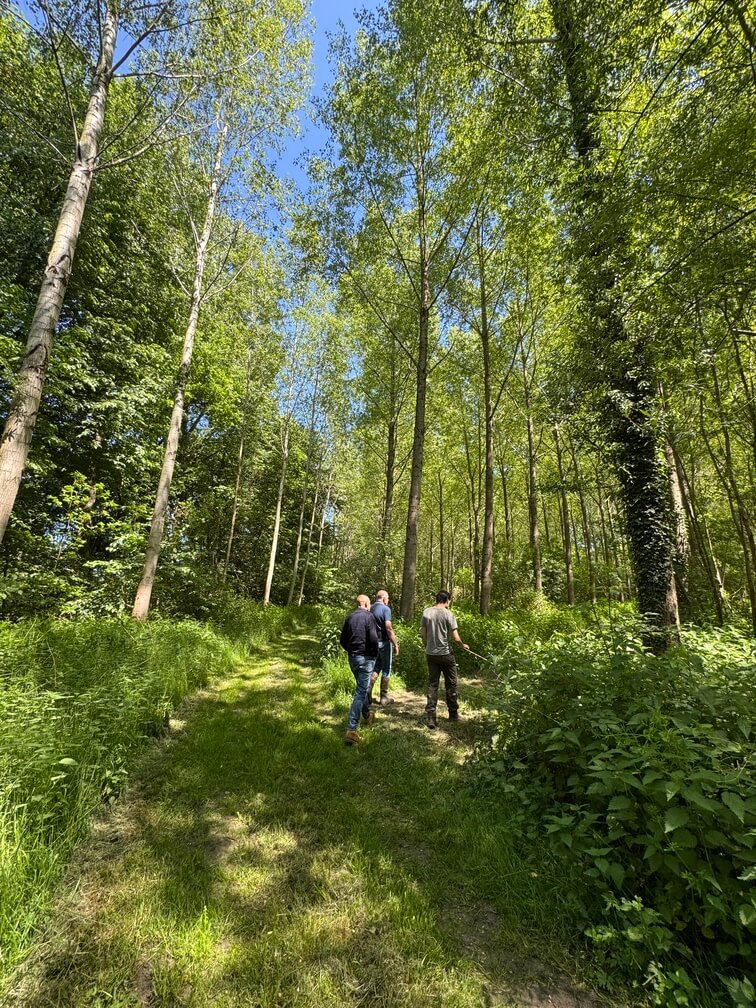The project team of Camino Verde in the Amazon Rainforest practices a variety of distinct kinds of reforestation and agroforestry as part of the forest restoration activities together with Go Forest.
“Sometimes we reforest from the ground up, in the way you might be imagining: a bare, completely deforested parcel is planted with seedlings that then fill in the bare area on the map with the greenery of tree canopies. In our case, this style of planting is carried out on some of our managed parcels that are bare due to the activities of the past owners – mainly, slash-and-burn agriculture,” explains our local project partner.
“Many of the areas where planting occurs, however, already possess some kind of tree cover at the time of planting. In other words, we’re not starting with a bare patch on the map. In this case, we’re mainly talking about two different planting systems: enrichment planting in secondary forest, and successional agroforestry.”

Enrichment planting in a secondary forest
A secondary forest is what springs up after a cleared area is abandoned. Whether a patch of land is cleared due to artificial causes (meaning, human activities such as slash-and-burn agriculture) or natural causes (such as a river changing its course), ecological succession sets in, and pioneer trees start growing back right away.
Secondary forests are like the immune system of the landscape, quickly generating organic matter in the form of leaf litter to build soils in sites that are sometimes sterile sand (not soil) before the secondary forest gets to work. Secondary forests are quite different than old, pristine, primary forests. Only a few tree species predominate in the secondary forest for its first 50 years of growth, with the whole diverse range of tree species found in the primary forest being introduced little by little, by birds and other animals. Permanent or long-term primary forest trees must wait their turn in the shade to become established, finally getting to grow fully only when one of the pioneer trees falls and creates a light gap. The whole process of succession to return a bare patch of ground to something that possesses the diversity of a primary forest can take 200 years or more.
Secondary forest enrichment planting is a way to speed up that process of succession, which, in this case, also means speeding up the introduction of species of trees that are useful for human needs, including endangered species. When trees are planted in a secondary forest, a broader range of biodiversity is introduced back into the landscape sooner. In practical terms, straight trails are created through the secondary forest and trees are planted all along those trails. Because of the shade provided by the pioneer trees’ canopy, these enrichment strips only need to be weeded once or twice a year, a saving in work compared to planting trees on a bare plot, where weed growth can require monthly maintenance clearing.

“To date, we have planted over 5 hectares of secondary forest with enrichment strips of important species such as ungurahui (Oenocarpus bataua), which gives edible fruits, and mahogany (Swietenia macrophylla), the Amazon’s most valuable timber tree.”
Successional agroforestry
One school of agroforestry, or “farming with trees”, is called successional agroforestry.
What this label implies is that when you design your agroforestry system, you take into consideration not only the physical dynamics of a forest’s shape (how trees grow with each other compatibly in space) but also the importance of the factor of time. Different species appear in the system (or disappear from the system) at different times. For example, in many successional agroforestry systems, annual or short-lived perennials (such as maize and bananas) are planted in the system at the beginning, later harvested, and then disappear from the system. Trees are planted at the beginning of the system’s establishment, but other trees (especially shade-loving ones) are planted into the system later in its lifespan.

“In many of our agroforestry areas, we plant trees under the established canopy of trees that were planted back at the beginning of the system. Trees like cacao (Theobroma cacao) and huasaí (Euterpe precatoria) benefit from the forest-like conditions and do better when established in shade versus when established in a clear, open patch. As a result, we often plant trees in areas that already have some established trees, sometimes we have even 5- or 10-year-old trees as the canopy overhead. While many of the trees planted in the understory are relatively small (like cacao), others, like huasaí, grow up into the canopy eventually and are structurally compatible with interplanting among other trees. Huasaí is a palm tree and therefore always grows straight, never branching, allowing it to be placed in the system in a way that is harmonious with already established trees.”
“In several areas, banana trees are planted at the beginning of the system’s life span. But these giant trees are productive for only a few years, and then are removed from the system. The gaps formerly occupied by the banana trees are then planted with new trees, including large, long-lived species like the Brazil-nut tree (Bertholletia excelsa).”










